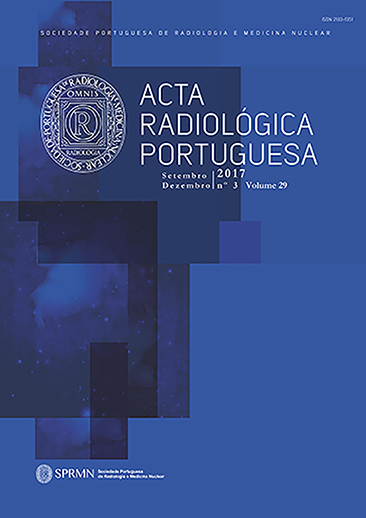Embolização Percutânea da Artéria Epigástrica Superior no contexto de Hematoma dos Músculos Rectos do Abdómen: a Propósito de dois Casos Clínicos.
DOI:
https://doi.org/10.25748/arp.12588Resumo
Os hematomas dos músculos rectos abdominais são uma complicação frequente em doentes anticoagulados. Apesar da maioria ser tratada de forma conservadora, podem por vezes evoluir de forma potencialmente fatal. O embolização percutânea transarterial surge como uma alternativa terapêutica eficaz nesses casos. Contudo, na sua maioria, estão descritos na literatura hematomas com origem na artéria epigástrica inferior. Com estes dois casos clínicos, a par da revisão da literatura, os autores pretendem alertar para a necessidade de estudar o território epigástrico superior em doentes com hematomas com extensão ao 1/3 superior da parede abdominal anterior ou sem resolução após embolização do território da artéria epigástrica inferior.
Referências
Smithson A, Ruiz J, Perello R et al. Diagnostic and management of spontaneous rectus sheath hematoma. Eur J Intern Med. 2013;24(6):579-82.
Berná JD, Zuazu I, Madrigal M, et al. Conservative treatment of large rectus sheath hematoma in patients undergoing anticoagulant therapy. Abdom Imaging. 2000; 25(3):230-4.
Zissin R, Gayer G, Kots E, et al. Transcatheter arterial embolisation in anticoagulant-related haematoma--a current therapeutic option: a report of four patients and review of the literature. Int J Clin Pract. 2007;61(8):1321-7.
Rimola J, Perendreu J, Falcó J, et al. Percutaneous arterial embolization in the management of rectus sheath hematoma. AJR Am J Roentgenol. 2007;188(6):497-502.
Cherry WB, Mueller PS. Rectus sheath hematoma: review of 126 cases at a single institution. Medicine (Baltimore). 2006;85(2):105-10.
Luhmann A, Williams EV. Rectus sheath hematoma: a series of unfortunate events. World J Surg. 2006;30(11):2050-5.
Sobkin PR, Bloom AI, Wilson MW, et al. Massive abdominal wall hemorrhage from injury to the inferior epigastric artery: a retrospective review. J Vasc Interv Radiol. 2008;19(3):327-32.
Landefeld CS, Beyth RJ. Anticoagulant-related bleeding: clinical epidemiology, prediction, and prevention. Am J Med. 1993;95:315–27.
Popov M, Sotiriadis C, Gay F et al. Spontaneous Intramuscular Hematomas of the Abdomen and Pelvis: A New Multilevel Algorithm to Direct Transarterial Embolization and Patient Management. Cardiovasc Intervent Radiol. 2017;40:537-45.
Boyd JB, Taylor GI, Corlett R. The vascular territories of the superior epigastric and the deep inferior epigastric systems. Plast Reconstr Surg. 1984;73(1):1-16.
Zink SI, Ohki SK, Stein B, et al. Noninvasive evaluation of active lower gastrointestinal bleeding: comparison between contrast-enhanced MDCT and 99mTc-labeled RBC scintigraphy. AJR Am J Roentgenol. 2008;191(4):1107-14.
Downloads
Ficheiros Adicionais
Publicado
Edição
Secção
Licença
Autor (es) (ou seu (s) empregador (es)) e ARP 2024. Reutilização permitida de acordo com CC BY-NC. Nenhuma reutilização comercial.



